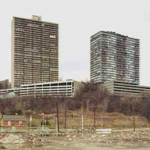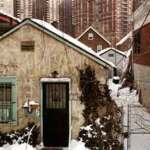In 1975, the International Museum of Photography at George Eastman House in Rochester rang a death knell on the landscape photography as popularized in the previous decades by artists like Ansel Adams, Eliot Porter, Paul Caponigro, and Minor White. The show was christened “New Topographics: Photographs of a Man-Altered Landscape” by curator William Jenkins to describe a new trend in landscape photography: a pseudo-anthropological, somewhat ironic observations of flat space usage by means of an objective and detached viewpoint. This new attitude was equated with a "styleless" style of photographic representation, echoing not only work by American photographers Walker Evans and Bernice Abbott but also countless itinerant and commercial photographers of the nineteenth century. This formalist heritage recycled by a new generation, now guised a new post-modern conscientiousness of the contemporary landscape. Represented in this show were Robert Adams, Lewis Baltz, Bernd and Hilla Becher, Joe Deal, Nick Nixon, Frank Gohlke, John Schott, Stephen Shore, and Henry Wessel Jr. This mostly male cast signified a paradigm shift in not only attitudes toward a three-decade-old-post-World War II American landscape, but of photographs being marketed as art within the context of the minimalist art boom of the time.
Following in this precedent nearly thirty years later is the work of Anna Collette shown this past month at Bernard Toale Gallery. Approached in a similarly flat affect as the work featured in “New Topographics”, the show consisted of numerous large scale color photographs representing the pluralization of housing styles in the New York/New Jersey area. Specifically, they document the intrusion of high-rise apartment buildings into areas already populated by hamlets of shingle roofed, cozy two family styled houses.
This apartment architecture is now an antiquated mid-century technostyle that failed to fulfill the promise of a successful municipal utopia. A vertical Leavittown for an urban space, these apartments are designed to be affordable by maximizing the ratio of tenants per property space, thus democratizing the spaces, making them all functionally equal. Though the spaces resist significant structural varieties, those who inhabit those spaces find ways to personalize it, expressing their perceptions of home within it. On closer view, some of these personal expressions are manifested in copies of the American flag draped over the railing of the suspended patio, skirting grills from Home Depot behind them.
In the photographs these structures are haunting. Why is that? To better fulfill the definition of their purpose, they should have littered the landscape, necessitating the demolition of the neighborhoods of individual houses in the foreground. The fact that the apartment buildings stand isolated and singular testify failure of the death as a rational, constructed solution to a spatial, urban problem. They are monuments to their own failure.
Besides, people don’t like to be seen as spatial, urban problems. Many reject making a home in this type of architecture. Most prefer to be individuals who have the have the luxury of owning individual houses. The American ideal of the individual house takes the form of a truncated box with an obtuse angled, shingle-laden roof. Why this archetype?
J. B. Jackson, a cultural essayist on landscape and architecture, described this preference in of housing styles goes back to the nineteenth century as, ”an exploration of rural life by antiquarians and those dissatisfied with urban industrial life"(1). This resistance to practical, urban architecture led to the development of "vernacular" architecture. Though the form is old, the need to adhere to that form was a new phenomenon in conservative views of America as a rural, agrarian society. Jackson also describes the vernacular dwelling as, "designed by a craftsman, not an architect, that is built with local techniques, local materials, and with the local environment in mind: its climate, its traditions, its economy - predominantly agricultural"(2). When the houses in Collette's photographs were built, there was a need to fill open space. The prevailing “vernacular” architecture perfectly fit this need. It was (and still is) individual, conservative, and agrarian (front yards are an evolution in agriculture and cultivation). However, back off from these houses to the distance that the apartment high-rises are shown and the traditionally styled homes start to look appear hopeless as personalized environments. They fail to differentiate significantly, making every pizza delivery a challenge. What matters to the occupants, though, is meaningful difference. These differences are personalized and can be as insignificant as a custom doorbell. When many of these houses were built, the “timeless” style of the American house was firmly settled into the people's expectations as the standard for a dwelling. Deviating from this format can be seen as an act of defiance on the majority of the local environment. The international style of the apartments is invasive because it is not a regional, indigenous style, but rather a universal form that threatens the specificity of a given locality. The architectural xenophobia is heightened by the loss of place its particular atmosphere. As a metaphor, the profusion of various "beware of dog" signs underlined by this threat of spatial invasion, which manifests itself as a fear of bodily trespass.
So much for pseudo-anthropological, somewhat ironic observations of flat space usage by means of an objective and detached viewpoint!
- Untitled #17, 2003; C-print, 30” x 40”.
- Untitled #11, 2002; C-print, 30” x 40”.
- Untitled #7, 2003; C-print, 30” x 40”.
----
(1) Jackson, J. B., Discovering the Vernacular Landscape, Yale University Press, New Haven, 1984, 85.
(2) Ibid, 85.
Links:
Bernard Toale Gallery
"Anna Collette: New Photographs" was on display between February 18 - March 27, 2004 at Bernard Toale Gallery.
All images are courtesy of Bernard Toale Gallery, Boston.
Matthew Gamber is a Boston-based photographer and teacher.







